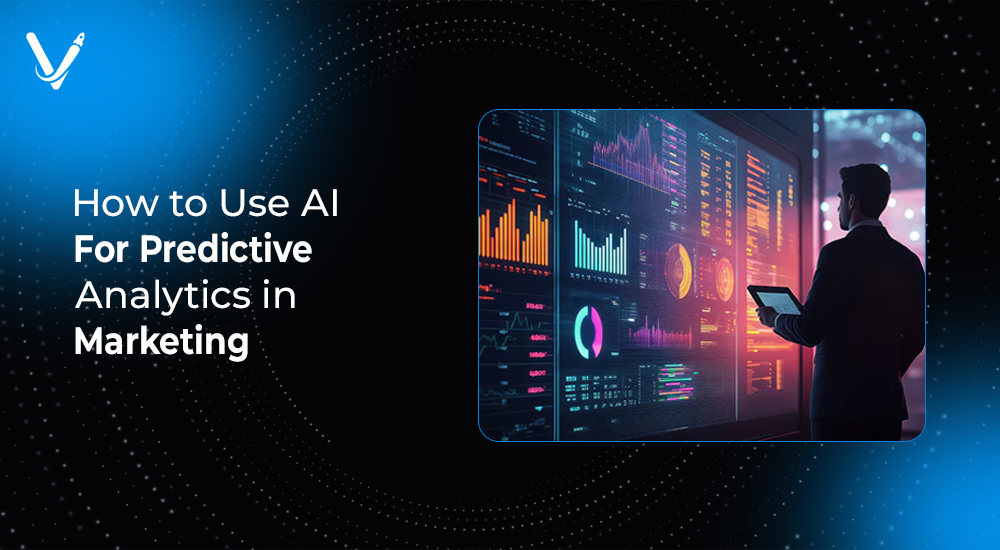How to Use AI for Predictive Analytics in Marketing


- May 24, 2025
Marketing today is no longer just about creative slogans or catchy taglines. It's a science powered by data, and businesses that harness this data effectively are winning. In 2025, the most successful marketers aren’t just reacting to what customers do—they’re predicting what they’ll do next. The secret? AI and predictive analytics.
This comprehensive guide will walk you through what predictive analytics means in the marketing world, how AI is revolutionizing it, the tools you need, and how to implement these strategies in real-time campaigns. We’ll explore real-world examples, latest advancements in predictive modeling and scenario analysis 2025, and provide actionable advice to give your marketing strategy a competitive edge.
Predictive analytics is the process of using historical data, statistical algorithms, and machine learning techniques to identify the likelihood of future outcomes based on past behaviors. In marketing, this translates to anticipating customer behavior—such as purchases, churn, or engagement—and optimizing campaigns accordingly.
When combined with AI in business analytics, predictive models become more accurate, adaptive, and scalable—opening new doors for marketers to engage smarter, not harder.
Artificial Intelligence has accelerated the power and precision of predictive analytics. Traditional predictive models required weeks to develop, test, and deploy. With AI, the process becomes faster, automated, and continuous.
AI systems scan massive volumes of customer interaction data, such as:
The AI then uses pattern recognition to identify trends and behaviors that often lead to conversions or drop-offs.
For example, AI might identify that customers who click on three product pages and add a product to their cart are 80% more likely to purchase within 24 hours. With this insight, your team can automate reminders, offer discounts, or serve personalized content before the purchase window closes.
AI leverages a wide array of algorithms for predictive analysis, each with specific use cases. Some of the most widely used in marketing include:
Used to predict binary outcomes—such as whether a customer will buy or not. It’s common in email marketing, churn prediction, and lead qualification.
Ideal for segmenting customer populations based on multiple attributes (age, behavior, location). Used in campaign optimization and personalization.
Used for more complex pattern detection, such as image or voice-based marketing campaigns, or multichannel attribution.
Helpful in customer segmentation—identifying distinct customer groups without predefined categories.
Used for seasonal demand prediction, ad budgeting, and sales forecasting.
Amazon leverages AI to generate real-time product suggestions. By analyzing browsing and purchase behavior using neural networks, Amazon predicts what you’ll buy next—driving an estimated 35% of its revenue through recommendation engines.
Netflix uses AI models to predict which shows you're likely to watch next. This includes personalized thumbnails, genre placement, and content promotions—all based on historical viewing patterns.
Spotify uses predictive insights to determine if a user is about to cancel their subscription. They analyze session lengths, skipped songs, and playlist activity. If a user appears likely to churn, Spotify offers exclusive content or discounts to retain them.
A global fashion brand used AI-driven predictive analytics to analyze email open rates, purchase behavior, and seasonal trends. The algorithm predicted optimal send times and subject line styles, increasing conversions by 28% within three months.
Begin by identifying where your customer data resides—CRM systems, email platforms, web analytics tools, etc. The more data you feed into the model, the better the predictions.
There are dozens of AI tools designed for marketers. A few popular options include:
Need help choosing the right stack? Our team at Vasundhara Infotech offers AI and analytics consulting to identify and integrate the right solutions.
Focus on questions like:
Use historical data to train your AI models. Validate predictions by comparing AI suggestions to actual outcomes.
Feed predictive results into your marketing automation tool. For instance, automatically send promo codes to high-potential users or initiate win-back campaigns for churn risks.
Predictive models evolve. Use latest advancements in predictive modeling and scenario analysis 2025 to refine your strategy, retrain models, and incorporate new behavior data.
Automatically rank leads based on their likelihood to convert, letting sales focus on high-priority contacts.
Anticipate when a customer is likely to leave and trigger retention campaigns ahead of time.
Serve custom content based on real-time behavioral signals. Predict what your users need before they even ask.
Estimate the long-term value of a customer, helping allocate resources to those who matter most.
Predict the best-performing channels and allocate ad spend accordingly. Combine with AI to adjust in real-time.
Modern marketers no longer wait until the end of a campaign to analyze performance. With predictive insights, you can:
By integrating predictive analytics into every stage—from planning to execution—you reduce guesswork and amplify return on investment.
In 2025, AI in business analytics is more than dashboards and reports. It acts as a co-pilot, proactively suggesting strategies, optimizing spend, and generating insights that humans might miss.
Marketers use AI to:
Case Study:
An e-learning company used predictive analytics to identify segments with the highest completion rate and lifetime value. They doubled down on acquisition for that segment using AI-generated ad creatives. The result: a 41% decrease in cost per acquisition (CPA) and increased retention.
Newer tools like Mutiny, Jarvis, and Clearscope AI offer predictive copywriting, image testing, and campaign sequencing built on top of predictive algorithms.
With increasing regulations (GDPR, CCPA), companies are moving toward privacy-safe AI systems that use anonymized behavioral data for prediction without infringing on personal information.
Some brands are training predictive models using synthetic datasets to test campaigns in virtual simulations before launch.
Voice-based product recommendations on platforms like Alexa and Google Assistant are now driven by predictive intent models—ushering in a new era of hyper-conversational, AI-powered marketing.
The fusion of AI and predictive analytics isn’t just a future trend—it’s already shaping how marketing decisions are made. Brands that use AI to forecast behavior, personalize engagement, and optimize campaigns in real time are consistently outperforming those that don’t.
By leveraging pattern recognition, algorithmic predictions, and scenario analysis, marketing teams can move from reactive to proactive—anticipating customer needs, maximizing lifetime value, and making data-driven decisions with confidence.
At Vasundhara Infotech, we help businesses implement scalable AI-driven marketing strategies that deliver measurable results. Whether you’re starting out with predictive modeling or looking to take your analytics to the next level, we’re here to guide your journey.
Ready to unlock smarter marketing? Contact us today and start building predictive-powered campaigns.
Copyright © 2025 Vasundhara Infotech. All Rights Reserved.
